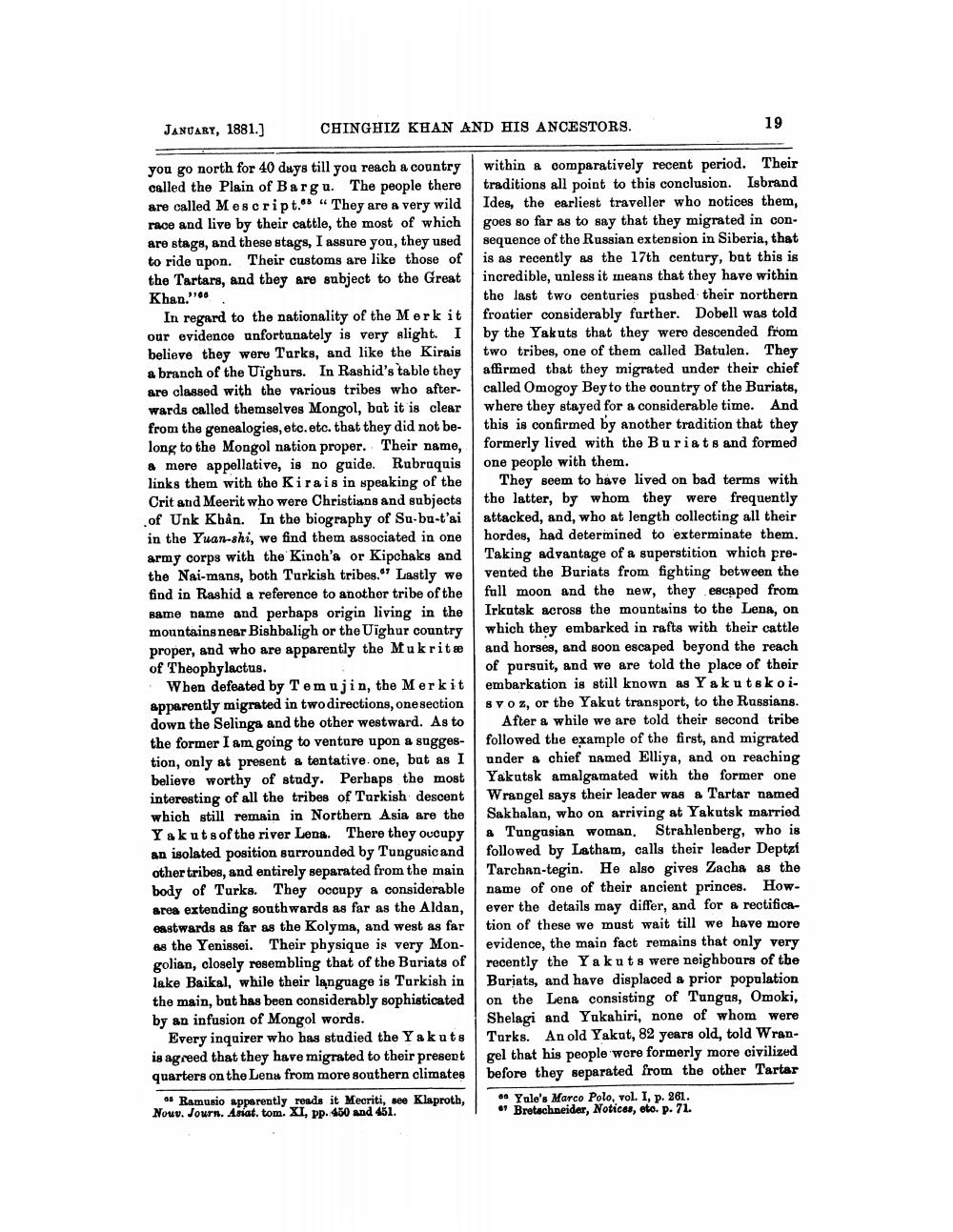________________
JANUARY, 1881.]
CHINGHIZ KHAN AND HIS ANCESTORS.
19
you go north for 40 duys till you reach a country called the Plain of Bargu. The people there are called Moscript. “They are a very wild race and live by their cattle, the most of which are stage, and these stags, I assure you, they used to ride upon. Their customs are like those of the Tartars, and they are subject to the Great Khan.''
In regard to the nationality of the Merk it our evidence unfortunately is very slight. I believe they were Turks, and like the Kirais a branch of the Uighurs. In Rashid's table they are classed with the various tribes who afterwards called themselves Mongol, but it is clear from the genealogies, etc.etc. that they did not be long to the Mongol nation proper. Their name, & mere appellative, is no guide. Rubraquis links them with the Kirais in speaking of the Crit and Meerit who were Christians and subjects of Unk Khản. In the biography of Su-bu-t'ai in the Yuan-shi, we find them associated in one army corps with the Kinch'a or Kipchaks and the Nai-mans, both Turkish tribes. Lastly we find in Rashid a reference to another tribe of the same name and perhaps origin living in the mountains near Bishbaligh or the Uighur country proper, and who are apparently the Mukritæ of Theophylactus.
When defeated by Temujin, the Merkit apparently migrated in two directions, one section down the Selinga and the other westward. As to the former I am going to venture upon a suggestion, only at present a tentative one, but as I believe worthy of study. Perhaps the most interesting of all the tribes of Turkish descent which still remain in Northern Asia are the Yakuts of the river Lens. There they occupy an isolated position surrounded by Tungusic and other tribes, and entirely separated from the main body of Turks. They occupy a considerable area extending southwards as far as the Aldan, eastwards as far as the Kolyma, and west as far as the Yenissei. Their physique is very Mongolian, closely resembling that of the Buriats of lake Baikal, while their language is Turkish in the main, but has been considerably sophisticated by an infusion of Mongol words.
Every inquirer who has studied the Yakuts is agreed that they have migrated to their present quarters on the Lena from more southern climates
Ramusio apparently reads it Meeriti, see Klaproth, 1 Nouv. Journ. Asiat. tom. XI, pp. 450 and 451.
within a comparatively recent period. Their traditions all point to this conclusion. Isbrand Ides, the earliest traveller who notices them, goes so far as to say that they migrated in consequence of the Russian extension in Siberia, that is as recently as the 17th century, but this is incredible, unless it means that they have within the last two centuries pushed their northern frontier considerably further. Dobell was told by the Yakuts that they were descended from two tribes, one of them called Batulen. They affirmed that they migrated under their chief called Omogoy Bey to the country of the Buriats, where they stayed for a considerable time. And this is confirmed by another tradition that they formerly lived with the Buriats and formed one people with them.
They seem to have lived on bad terms with the latter, by whom they were frequently attacked, and, who at length collecting all their hordes, had determined to exterminate them. Taking advantage of a superstition which prevented the Buriats from fighting between the full moon and the new, they escaped from Irkutsk across the mountains to the Lena, on which they embarked in rafts with their cattle and horses, and soon escaped beyond the reach of pursuit, and we are told the place of their embarkation is still known as Yakutskoi. Voz, or the Yakut transport, to the Russians.
After a while we are told their second tribe followed the example of the first, and migrated under & chief named Elliya, and on reaching Yakutsk amalgamated with the former one Wrangel says their leader was a Tartar named Sakhalan, who on arriving at Yakutsk married & Tungusian woman. Strahlenberg, who is followed by Latham, calls their leader Deptzi Tarcban-tegin. He also gives Zacha as the name of one of their ancient princes. However the details may differ, and for a rectification of these we must wait till we have more evidence, the main fact remains that only very recently the Yakuts were neighbours of the Buriats, and have displaced a prior population on the Lena consisting of Tungus, Omoki, Shelagi and Yukahiri, none of whom were Turks. An old Yakut, 82 years old, told Wrangel that his people were formerly more civilized before they separated from the other Tartar
Yule's Marco Polo, vol. I, p. 261. "Bretschneider, Notices, eto. p. 71.




